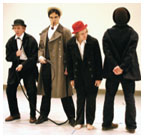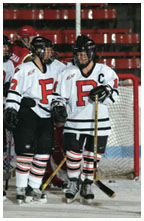
|
April 19, 2006: President's Page
THE ALUMNI WEEKLY PROVIDES THESE PAGES TO THE PRESIDENT
Waiting for Godot: seniors Jed Peterson, Paulo Quiros, Ben Mains, and John Doherty (left to right) bring Samuel Beckett’s timeless play to life in a senior thesis production directed by Tim Vasen of the Program in Theater and Dance. (Photo by AMY WIDDOWSON)
Much to celebrate: Christine Foster ’09, Sarah Butsch ’06, Heather Jackson ’06 (left to right), and their teammates led the women’s hockey team to its most successful season ever, winning 21 games and reaching the NCAA quarterfinals for the first time. (Photo by BEVERLY SCHAEFER) |
I have often remarked that the only shortcoming of Reunions is that they occur after most students have left for the summer. As a consequence, returning alumni miss the opportunity to experience for themselves what it means to live and work among some of the most accomplished students on the planet. Whether on the stage or on the playing fields, Princeton students are continually creating moments of excitement, intellectual engagement, or pure pleasure for audiences that include their friends, their teachers, members of the community and, luckily for me, administrators. One of the greatest perks of my job is the opportunity I have almost every day to be someplace on campus where students will astound me with their talents!
Let me give you just a few examples of the kinds of events I have attended this year. On February 11 the women’s hockey team played at Baker Rink. I grew up with skates on and cheered for the Toronto Maple Leafs every Saturday night on the CBC’s Hockey Night in Canada, so I have some appreciation for what it takes to play competitive hockey. That evening the team was on fire, skating to a 7-0 lead before beating the traditional powerhouse Dartmouth team by 7-2. This was midway through a season that saw Coach Jeff Kampersal ’92 take his team to its first Ivy championship since the 1991-92 season and to the ECAC quarterfinals against last year’s national champion, the University of Minnesota. What was most impressive to me was our players’ remarkable skating ability, their intelligent play-making and their esprit de corps.
On February 17 I attended a production of Waiting for Godot, the senior thesis production of Ben Mains ’06, in the Matthews Acting Studio at 185 Nassau St. To be frank, I went with some trepidation, as Samuel Beckett’s play is notoriously difficult to do well, and when done badly it can be excruciatingly long and boring. I overcame my reservations because of my admiration for Ben and his fellow senior class actors, Jed Peterson, John Doherty, and Paulo Quiros, whom I had seen in many plays over the last few years. Nothing could have prepared me, however, for the high quality of the production, or its power to move the audience. The play was completely engrossing—at one moment hilarious and at the next tragic. In the words of their director, Tim Vasen, “Waiting for Godot is the Mount Everest of the modern theater landscape: we all know it’s out there, we all acknowledge its importance, but few of us ever bother to make the climb.” These four seniors not only climbed their metaphorical Mount Everest, but took their audience with them.
On February 26 I attended the Spring Dance Festival at the Berlind Theatre, featuring the works of our certificate students in the Program in Theater and Dance. There I was transported by Maria Steele ’06, who choreographed and danced a duet—with The Best Seat in the House I her laptop computer. The piece was beautifully constructed to be whimsical, as a duet between a woman and a computer should be, but it was also surprisingly romantic. In the same program 11 students in the program staged Vaslav Nijinsky’s famous 1912 ballet “L’après-midi d’un Faune,” with a score by Claude Debussy. The original notation for the ballet, meticulously articulated down to the position of every finger and thumb, was lost after Nijinsky’s death, but was rediscovered by painstaking research in the 1980s. Nijinsky’s choreography was considered revolutionary in its time, while by modern dance standards it seems highly formalized today. From the sets and costumes to the disciplined and inspired dancing, the production was a stunning achievement.
On December 11 I attended a concert of the Princeton University orchestra that featured solos by baritone Sean Effinger-Dean ’06 and violinist and con- cert master Lauren Carpenter ’06, co-win- ners of the orchestra’s Concerto Competition. Both of these brilliant musicians chose to perform challenging works; Lauren played Brahms’ Violin Concerto in D Major, which is a beautiful and taxing piece, and Sean sang Gustav Mahler’s Songs of a Wayfarer with gusto and presence. Their performances were spell-binding, and reinforced something that the conductor of the orchestra, Michael Pratt, has said to me on several occasions. Today Princeton is attracting students of extraordinary musical ability who would have chosen to attend music conservatories in the past. Our Program in Music Performance allows them to pursue their music without sacrificing the chance to obtain a splendid liberal arts education.
My last event to report was also my most terrifying. Until Jamal Motlagh ’06 invited me to one of his water polo games at DeNunzio Pool in September, I had never seen water polo played in person. It took some time for me to get over my conviction that I was witnessing a series of underwater muggings that the referees were callously ignoring. However, once I was oriented to this exhausting and very exciting sport, I got into the swim of things and helped cheer our team to a 14-5 victory against Johns Hopkins. It is thrilling to me that after 20 years at Princeton, I am still discovering new student activities to enjoy.
The limited size of this page allows me to describe just a handful of
the many forms of athletic and artistic expression that take place on
our campus. But I hope you will understand what I mean when I say that
I have the best seat in the house. ![]()



